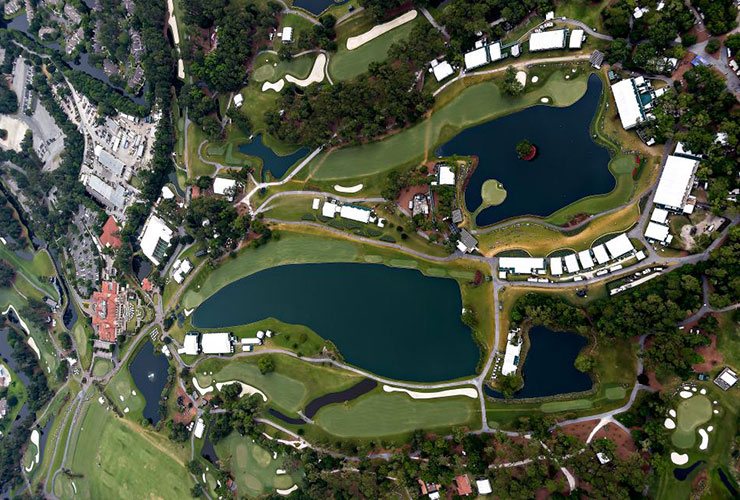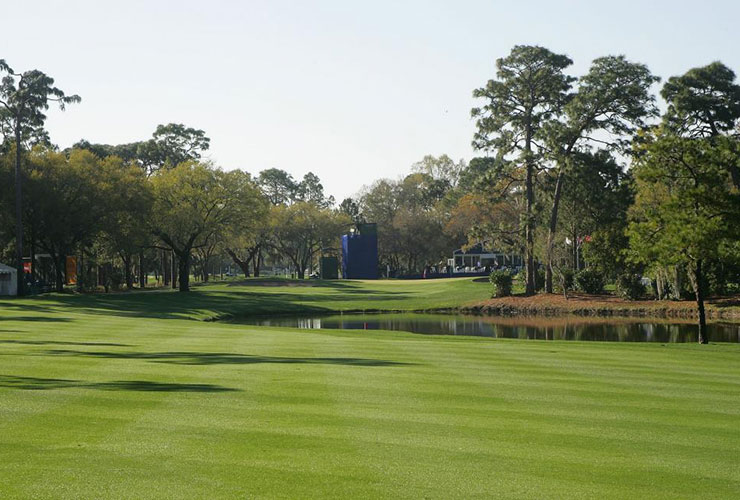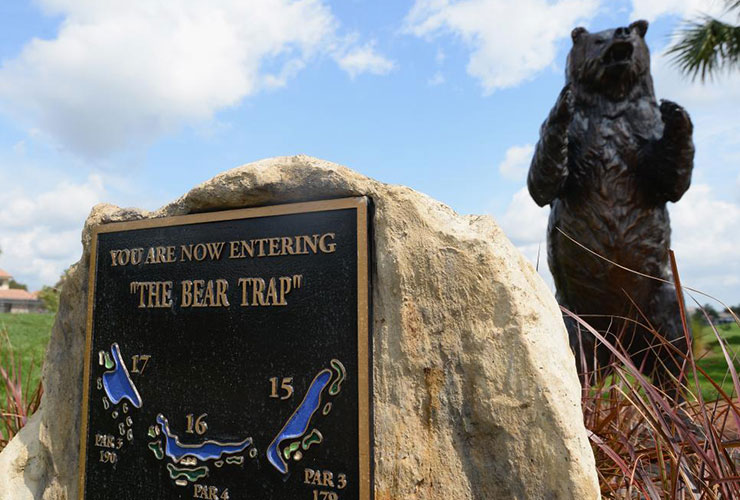You’ll hear a lot this week about PGA National’s Bear Trap at the Honda Classic. Here’s how it stacks up among the biggest challenges on the PGA Tour:
PGA National Golf Club: Bear Trap
Named for Jack Nicklaus, who redesigned the course, PGA National’s 15th, 16th and 17th holes are more than a marketing ploy: At the 2022 Honda Classic, the Bear Trap registered 305 bogeys or worse, up from 292 the previous year and 257 in 2019.
Augusta National: Amen Corner

Coined by Herbert Warren Wind, Augusta’s 11th, 12th and 13th constitute the most famous three-hole stretch in golf. While the 11th (the hardest hole during the 2022 Masters at 4.47 strokes) and 12th (3.23 strokes) live up to their tenacious reputation, the 13th has ranked as the easiest holes the past decade, which explains why Augusta has lengthened it by 35 yards ahead of the 2023 Masters. The accuracy required by Azalea’s tee ball will continue to make the drive one of the most important — and for viewers, exciting — shots during tournament time.
TPC Sawgrass: Closing three holes

The par-3, island-green 17th is one of the most famous holes in the world. But it’s merely a part of TPC Sawgrass’ closing puzzle. The 18th hole is actually tougher, boasting a +.530 scoring average during the 2022 Players, the highest number on the course. The par-5 16th was once a true risk-reward endeavour, although advances in club technology has rendered the 16th defenseless (it played to a scoring average of -.477).
Innisbrook Copperhead: The Snake Pit

Like my man Indiana Jones, I battle ophidiophobia, so let’s get through this quick. Copperhead’s final three holes — two 440-plus-yard par 4s, with a 215-yard par 3 sandwiched in between — is not necessarily a stretch to conquer, rather, a player just wants to get through unscathed. The 16th is the most gruelling, coming in at 475 yards with water running up the right side. It had a scoring average of +.111 at the 2022 Valspar Championship.
Quail Hollow Club: Green Mile

How about this for a finish: A 508-yard par 4 whose green is guarded by a lake on the left and bunker on the right, a 220-yard par 3 with a peninsula green and sand in the front; a 493-yard, uphill par 4 with a creek running up the left and bunkers scattered throughout. The numbers back the description up, as the 16th, 17th and 18th ranked 10th, second and first in scoring difficulty at the Wells Fargo Championship in 2021.
Colonial Country Club: The Horrible Horseshoe

How brutal is the three-hole stretch on Colonial’s front nine? So graphic that we can’t even show you a picture. … At last year’s Charles Schwab Challenge, Nos. 3, 4 and 5 holes ranked 11th, second and first in difficulty. The Horrible Horseshoe is highlighted by the fifth, a 481-yard, dogleg par 4 hugged by a creek and tree line. Dan Jenkins included the fifth hole for his book ‘The Best 18 Golf Holes in America’.
Bethpage Black: Nos. 10-12

Bethpage, host of the 2019 PGA Championship, has the infamous first-tee warning sign, the picturesque par-5 fourth hole, and the 15th ranked as one of the hardest holes in US Open history in 2002 and 2009. Yet, the start of Bethpage Black’s back nine — a trio of par 4s with a cumulative distance of more than 1,400 yards — ranks as the course’s toughest stretch, with players averaging +.284, +.175 and +.322 through the Black’s 10th-12th.
Carnoustie Golf Links: Nos. 16-18

In Jean van de Velde’s defence — that’s something you’ve never heard — it wasn’t like the Frenchman collapsed on an innocuous hole back at the 1999 Open Championship. At the 2018 Open, the 18th ranked as the fourth-hardest hole in the tournament, as players averaged a 4.237 score on the 499-yard, burn-and-bunker infused finisher. The 16th (a 250-yard par 3 with four bunkers and undulated green) and the 17th (creek-crossed 460-yard par 4) are no cake walks, either, ranking second and third in difficulty on the week.
Oakmont Country Club: Nos. 7-9

Most know Oakmont for its church pew bunkers, or No. 1’s reputation as the hardest opening hole in the game. Yet, it’s a three-hole stretch from the seventh to nine where Oakmont’s competitors get run through the wringer. At the 2016 U.S. Open, these holes were +.325, +.305 and +.431 over par.
Muirfield: Nos. 14-16

Theoretically, we could just nominate the entire course. When it last hosted the Open in 2013, seven of the toughest 20 holes on the PGA Tour that season came from Muirfield, with 10 ranking in the top 50. The Nos. 14-16 stretch is particularly sadistic: Length, unforgiving fairways and diabolical greens translated to a +1.116 over-par scoring bump at the 2013 tournament, making eventual champion Phil Mickelson’s performance here (birdie-par-par) all the more impressive.
Muirfield Village: Nos. 16-18

The last 10 winners of the Memorial Tournament own a collective 137-under score, leading one to believe Muirfield Village can’t be that tough. The course’s last three holes speak otherwise: A 200-yard par 3 over water, a suffocatingly tight 485-yard par 4 and a dogleg, uphill, every-obstacle-you-can-imagine 480-yard finisher are the type of closing stretch that keeps players up at night. All three ranked in the top-six hardest holes at the 2022 Memorial.
Pebble Beach: Nos. 8-10

These holes are nicknamed the “Cliffs of Doom”. Enough said.
Shinnecock Hills Golf Club: Nos. 12-14

The entire links was a beast at the 2018 US Open. But the 12th (+.336), 13th (+.271) and 14th (+.567) were especially brutal. That Phil Mickelson’s infamous hockey-putt came on the 13th should be no surprise.







